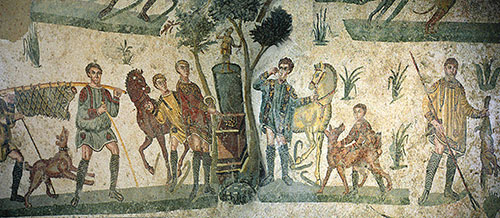
The Villa Romana del Casale dates back to the 4th Century A.D. It is located in the middle of Sicily,
in the Province of Enna and it is a magnificent rural dwelling, known all over the world for its stunning mosaics.
The archaeologist Gino Vinicio Gentili discovered its ruins in 1950 after the reporting of the local people.
The Villa Romana del Casale is one of the most important examples of official governmental residences. The villa, in fact, most likely belonged to a member of Rome’s senatorial class.
Allegedly, the late Roman villa was built over a pre-existing rural settlement, probably a farm built between the 1st and the 3rd century A.D. It had the same location of the baths of the villa and its foundations were discovered underneath some parts of the villa. The existence of the baths in ancient times reinforces the theory according to which it was the residence of a wealthy tenant or the administrator of a landowner.
The villa was built on a group of terraces and is divided into four monumental areas. The first area is the three arches monumental entrance, which opens onto a horseshoe-shaped courtyard; the bathrooms overlook the same yard. The second area is the main squared peristyle with the garden and a huge monumental fountain with 3 basins and the rooms that overlook it.
To the East of the main porch there is the long aisle, which is the anteroom of the basilica, known as the aisle of the “Big Hunt”: one of the most extraordinary mosaics floor, 350 m2 wide, depicts the capture of wild animals to be used in the circus shows in Rome.
The third area is around the Elliptical peristyle (porch) surrounded by some private apartments. Finally, the fourth area includes the thermal baths.
From the aisle of the Big Hunt, the Basilica can be reached, with the large a large reception room paved with polychrome marbles from all the Mediterranean area. Most of the small private rooms of this part of the villa feature mosaic floors depicting more peaceful scenes and domestic activities.
To the South of porch there is the well-known mosaic representing a group of young women wearing very modern bikinis, while doing sports.
The mosaics are the most prestigious element of the Villa del Casale and date back to a more advanced period of the mosaic art and were probably the work of artists from North Africa, considering both the quality and the scenes representing various themes: mythology, hunting, plants and wildlife, domestic scenes and much more. From a stylistic point of view, there were at least two mosaic masters who worked for the villa: one with a more classical style created mainly mythological scenes; the other one, with a more realistic approach, depicted daily-life scenes.
The Villa Romana del Casale is accessible for people with wheelchair for the 60-70% of the site. It can be reached through a path of about 150 meters, with a small street paved with sandstone. All other paths within the villa are paved with clay court or opus signinum and the boardwalk are paved with a smooth opus signinum. Parking areas for disabled are provided and the villa is easily accessible. The exhibition areas feature signs and maps and rest stops are available. The property offers an accessible toilet.
Audio guides available.
Useful information
Address: Contrada Casale – Piazza Armerina (En)
Contact details: ph. +39 0935-680036 – email: museo.villacasale@regione.sicilia.it
The Villa is open every day of the year, included public holidays (December 25th and 1st January excluded).
Mon-Sun: 9.00 a.m. to 7.00 p.m. from last Sunday of March to the last Saturday of October
Mon – Sun: 9.00 a.m. to 5.00 p.m. from last Sunday of October to last Saturday of March. The ticket office closes 1 hour prior the exit times.
Tickets costs:
€ 10,00 full price – € 5,00 reduced price. Free entrance: the first Sunday every months; people under 18; disabled people and their helpers. A cumulative ticket is available for Villa del Casale, Morgantina and the Museum of Aidone: € 14 (valid 3 days).
On Fridays, Saturdays and Sundays in July and August, the ticket office is open from 9 a.m. to 11 p.m.
Exit is by 11.30 p.m.


